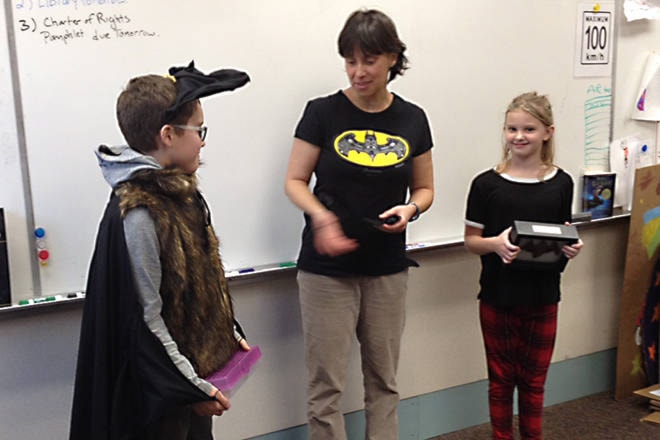Uplands Elementary School students are batty about bats.
“I like bats because they are important,” said student Tabitha Young. “Bats don’t have a voice and we need to stand up for them.”
Grades 4 and 5 students learned about bats and decided to take action after finding out how important bats are to the environment.
“I thought bats were just regular animals, but I learned that they are important because in summer, they keep the bug population down,” said 10-year-old Cruz Schoening. “There are 14 species of bats in the Okanagan, all of them consume insects and a few even eat spiders. There are no fruit or vampire bats in Canada.”
Related: Bat stats — public’s help needed in tracking activity
| Penticton students Cruz Schoening and Tabitha Young raised over $100 towards bat conservation. Photo courtesy of Paula Rodriguez de la Vega |
Uplands teacher David Hird uses bats as part of his science curriculum. He had a biologist come in to do a bat presentation through the Okanagan Similkameen Conservation Alliance Ecostudies program.
“We’ve learnt so much. Bats are as important as bees. We need them,” said Hird.
Related: Bat week in the Okanagan
The students said they are very concerned about the threat of white-nose syndrome (WNS), a fungal disease responsible for the death of millions of bats in eastern North America. Confirmed in Washington State in 2016 and 2017, the presence of the fungus is very worrisome for the health of bat populations in British Columbia, with near 100 per cent mortality for some species of bats exposed to the fungus. Although devastating for bats, WNS does not affect humans.
The typical first sign of WNS is bats flying during the winter, an unusual sighting at a time of year when bats are hibernating. Another sign of the presence of the disease is the appearance of dead bats as they succumb to the effects of WNS. If you find a dead bat or see winter bat activity, report it to the CBP (1-855-922-2287 ext. 13, or okanagan@bcbats.ca) as soon as possible for further information. The bat program organizers warn to never touch a dead bat with your bare hands.
Students at Uplands Elementary also have had first-hand experience with bats, as every fall, one to three bats make their appearance for a few days, as they roost and take shelter on the exterior wall of the school.
“This has been a wonderful opportunity for students to learn that bats are wildlife, not pests, and that they are protected under the BC Wildlife Act,” said Paula Rodriguez de la Vega, co-ordinator with the BC Community Bat Program. “Bats should never be handled, and it is illegal to harass or kill them. The best thing to do is to leave them alone.”
To report a typo, email: editor@pentictonwesternnews.com.
<>@PentictonNews
newstips@pentictonwesternnews.com
Like us on Facebook and follow us on Twitter.
